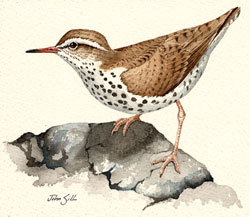Breeding Bird Atlases (BBA)
Find a Bird - BBA1
Breeding Bird Atlas 1 Species Accounts
Spotted Sandpiper
Actitis macularia
Egg Dates
May 6 to July 5
Number of Broods
one; may re-lay if first attempt fails.

The familiar Spotted Sandpiper, or Teeter-up, is a common migrant and fairly common breeding species throughout the state. Although it is frequently encountered along the shores of freshwater lakes, ponds, and streams, it is more abundant both as a migrant and as a summer resident along the seacoast.
A few Spotted Sandpipers arrive in late April, but it is not until the early part of May that they become evident on a wide scale. Assemblages of migrants are sometimes encountered along the coast in mid-May. By late May, most of the resident breeders are paired. At this time, when an observer approaches along a shoreline, a Spotted Sandpiper will fly out over the water in distinctive bowed-winged flight, uttering a peet-weet call.
In this species, it is the slightly larger female that is more aggressive, defending territory and courting males. When displaying, a female flies up and then glides in to land near a prospective mate. She may strut about like a miniature turkey. Both sexes give a weet-weet-weet-weet-weet call during courtship.
In some cases, Spotted Sandpipers form monogamous pair bonds. Studies have shown that females may be polyandrous, mating with two to four males in succession and sharing parental duties with the final mate. It appears that even when the female is present, the male assumes most of the responsibility of incubation and care of the young.
The nest is located on the ground and is generally a hollow, lined sparingly with grasses. Along the coast, the nest may be no more than a shallow depression in the dunes. Although the nest is usually placed near water, Spotted Sandpipers may select a site at the edge of a cultivated field or other area of sparse vegetation some distance from water.
The usual shorebird complement of four eggs (sometimes two, three, or five) is completed by the end of May. Later clutches probably represent attempts at renesting. Incubation lasts 20 to 24 days, and the chicks leave the nest soon after hatching, although they may return there in the evening to be brooded. The cryptically marked young quickly adopt the curious and comical bobbing behavior of the adults. Nine Massachusetts records of an adult with one to four young range from June 1 (chicks several days old) to July 17. The latest date for a downy youngster was July 14 (CNR, TC). The young fledge when they are about 17 days old, at which time the family breaks up.
Spotted Sandpipers are rather inconspicuous in midsummer, at which time the adults molt into a drab plumage that lacks their distinctive black-spotted underparts and resembles that of the young of the year. Fall migration (which is underway by August) is less obvious than the spring migration and is more apparent inland; small groups are found frequently along the receding shorelines of reservoirs and lakes. By the end of September, Spotted Sandpipers have departed from our area, although there are occasional sightings into early December. Most individuals winter in Central America and northern South America.
Map Legend and Data Summary
Atlas 1 data collected from 1975-1979


Note: common and widespread, usually near open water but occasionally in damp meadows
Richard A. Forster and W. Roger Meservey



